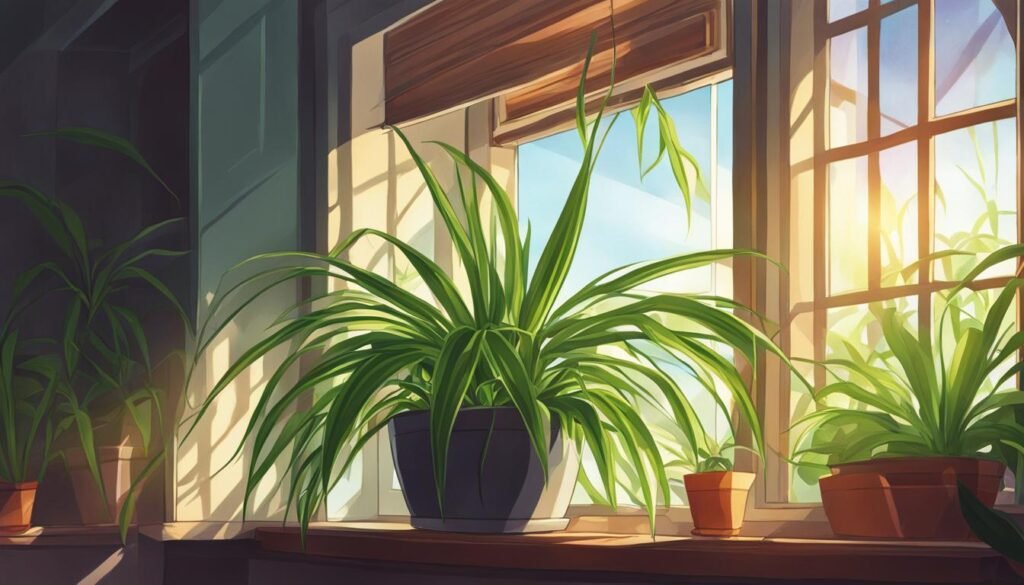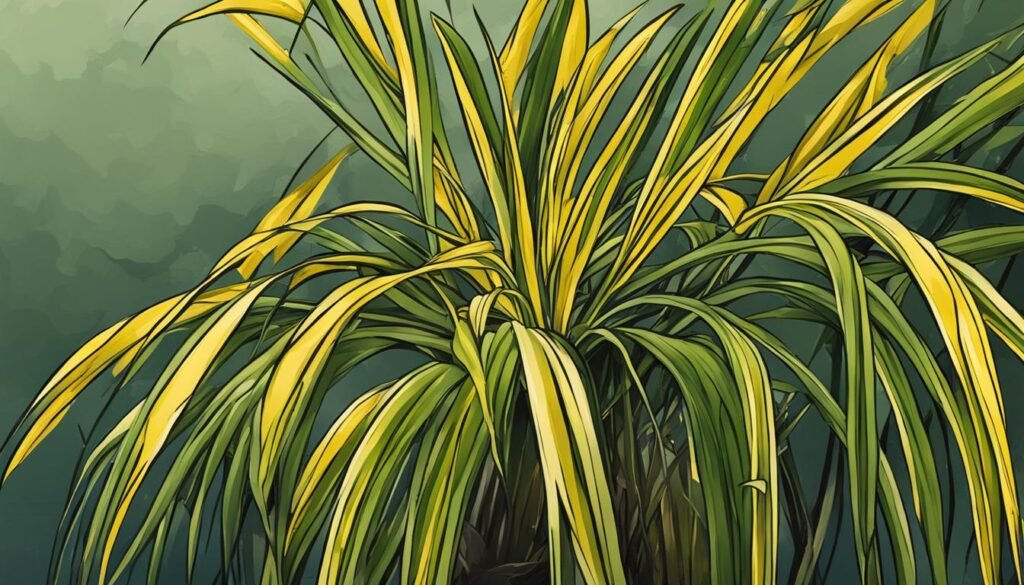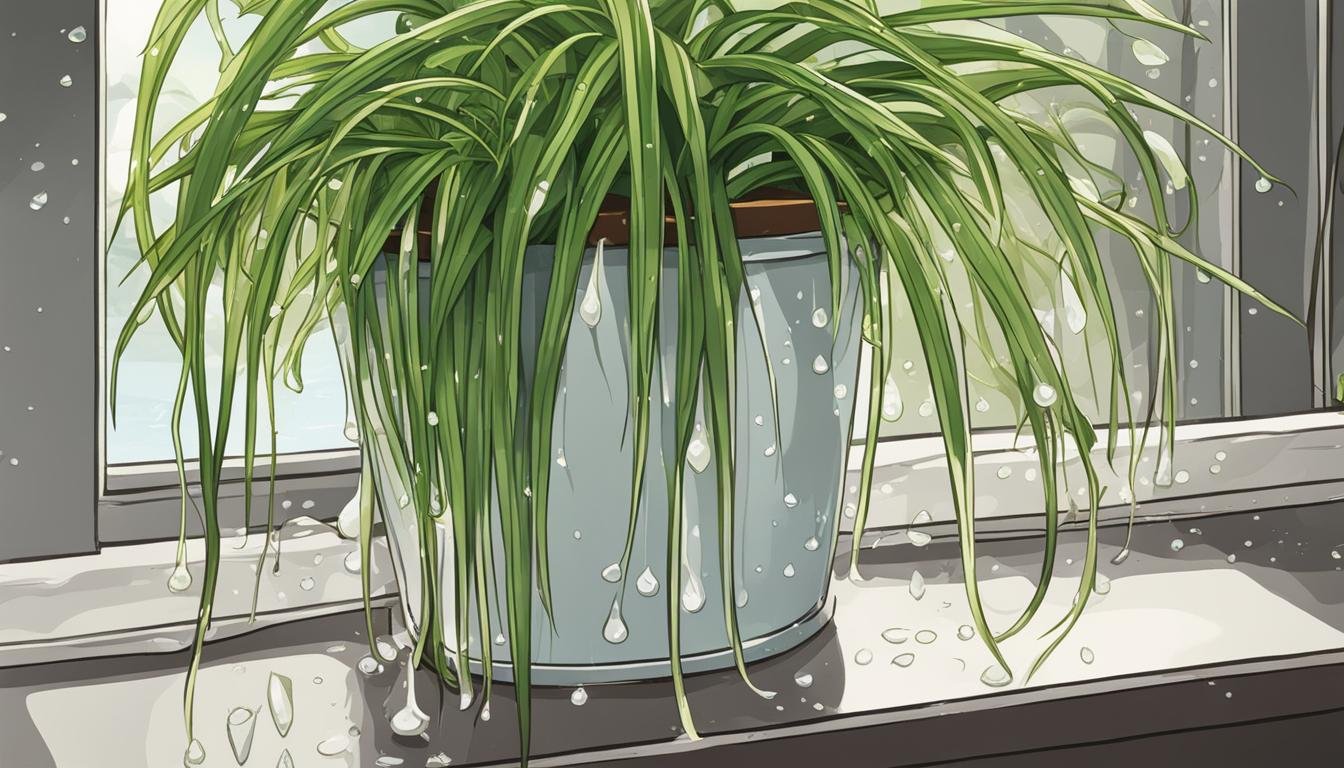Spider plants are popular houseplants known for their attractive appearance and ease of care. However, they can sometimes start to wilt and show signs of distress. In this article, we will explore the common causes of a dying spider plant and provide helpful solutions to revive it. We will discuss issues such as overwatering or underwatering, inadequate light, container size, nutrient deficiencies, and more. By understanding the reasons behind a dying spider plant and implementing the appropriate care, you can help your plant thrive once again.
Key Takeaways:
- Spider plants can wilt and die due to overwatering, underwatering, inadequate light, container size, and nutrient deficiencies.
- Proper watering is crucial – find the right balance and avoid root rot or dry foliage.
- Provide adequate light by placing your spider plant in a bright, indirect sunlight location.
- Ensure your plant has enough space to grow by repotting it in a suitable container.
- Feed your spider plant with a balanced liquid organic fertilizer to prevent nutrient deficiencies.
Overwatering and Underwatering: Finding the Right Balance
Proper watering is essential for the health of your spider plant. Overwatering and underwatering are common issues that can lead to the decline of your plant. Overwatering, in particular, can cause root rot, which is detrimental to the overall well-being of your spider plant. On the other hand, underwatering can result in the plant becoming dehydrated and withered.
To ensure the right balance of watering, it’s important to pay attention to the moisture levels in the soil. Stick your finger about an inch deep into the soil; if it feels dry, it’s time to water your spider plant. However, if the soil feels moist, it’s best to hold off on watering. Remember, spider plants prefer slightly drier conditions compared to other houseplants.
“Overwatering is one of the most common mistakes made by spider plant owners. The roots of the spider plant are prone to rot if they sit in waterlogged soil for too long. It’s important to provide adequate drainage by using well-draining soil and pots with drainage holes.”
If you notice signs of overwatering, such as yellowing or browning of leaves, consider adjusting your watering schedule. Allow the soil to dry out between waterings and make sure your pot has proper drainage. On the other hand, if your spider plant is wilting and the soil feels bone dry, it’s a sign of underwatering. Increase the frequency of watering and ensure that the soil retains some moisture without becoming waterlogged.
Signs of Overwatering
- Yellow or brown leaves
- Drooping or wilting foliage
- Musty or unpleasant smell from the soil
Signs of Underwatering
- Dry and withered leaves
- The soil feels extremely dry to the touch
- Slow or stunted growth
Providing Adequate Light: Avoiding Sunburn and Insufficient Light
Proper lighting is crucial for the health and vitality of your spider plant. These plants thrive in bright, indirect light, which mimics their natural environment. However, it’s important to avoid exposing them to too much direct sunlight, as this can lead to sunburn. To ensure that your spider plant receives the right amount of light, position it in a location with bright, indirect sunlight. This can be near a north or east-facing window, where the light is filtered through curtains or blinds.
If your spider plant is exposed to direct sunlight, you may notice the tips of the leaves turning brown or the foliage losing its vibrant green color. To prevent this, consider moving your plant to a slightly shadier spot or placing a sheer curtain or blind to filter the sunlight. This will help protect the leaves from excessive heat and potential sunburn.
On the other hand, insufficient light can also impact the growth of your spider plant. If you notice that your plant is not thriving or the leaves are turning yellow, it may be an indication of insufficient light. In this case, consider moving your spider plant to a brighter location. You can also supplement the natural light with artificial grow lights, which provide the necessary spectrum for plant growth.
Sunlight Requirements for Spider Plants:
- Spider plants require bright, indirect light.
- Position the plant near a north or east-facing window.
- Avoid exposing the plant to direct sunlight to prevent sunburn.
- Consider supplementing natural light with artificial grow lights if needed.

“Proper lighting is crucial for the health and vitality of your spider plant.”
“Position it in a location with bright, indirect sunlight.”
Container Size and Root Health: Ensuring Adequate Space
Proper container size and healthy root growth are essential for the well-being of your spider plant. If your plant is showing signs of wilting or stunted growth, it may be time to check if it has outgrown its current pot. Spider plants have vigorous root systems, and when they become root-bound, it can hinder their growth and affect their overall health.
To determine if your spider plant needs a larger container, carefully lift it from its current pot and examine the roots. If you see a dense mass of roots circling around the bottom or sides of the pot, it’s a clear indication that your plant needs more space. Repotting the spider plant into a larger pot will provide room for the roots to spread and promote healthy growth.
When repotting, choose a pot that is one size larger than the current one. Make sure the new pot has drainage holes to prevent waterlogging, which can lead to root rot. Before placing your spider plant in the new pot, gently tease apart the root ball to encourage new growth and prevent the roots from becoming bound again.
Quick Tips for Repotting a Spider Plant:
- Choose a well-draining potting mix specifically formulated for indoor plants.
- Place a layer of fresh soil at the bottom of the new pot.
- Position the spider plant in the center of the pot and fill in the sides with soil, gently pressing it down to remove air pockets.
- Water the newly repotted plant thoroughly and place it in a location with bright, indirect light.
By providing an appropriate container size and ensuring healthy root growth, you can help your spider plant thrive and prevent issues such as wilting or stunted growth. Remember to monitor your plant’s growth and consider repotting every 1-2 years to maintain its health and vitality.
Nutrient Deficiencies: Feeding Your Spider Plant
Proper nutrition is essential for the health and vitality of your spider plant. Nutrient deficiencies can cause the leaves to appear sad and withered, but with the right feeding regimen, you can help your plant thrive. Feeding your spider plant with a balanced liquid organic fertilizer is a great way to provide the necessary nutrients for healthy growth.
Organic fertilizers are highly recommended for spider plants as they help avoid chemical and salt buildup in the soil, which can lead to leaf tip burn. Look for an organic fertilizer specifically formulated for houseplants and follow the instructions for application. Typically, it is best to fertilize spider plants once a month during the growing season, which is spring through summer.
“Feeding your spider plant with a balanced liquid organic fertilizer is a great way to provide the necessary nutrients for healthy growth.”
When applying the fertilizer, dilute it to half the recommended strength to prevent over-fertilization, which can cause leaf burn and other issues. Water your spider plant thoroughly before applying the fertilizer to ensure proper absorption. Avoid applying fertilizer to dry soil as it may cause root damage.
Signs of Nutrient Deficiencies
If your spider plant is showing signs of nutrient deficiencies, such as yellowing leaves, stunted growth, or poor overall health, it may be a cue to provide it with some extra nourishment. Additionally, if your spider plant hasn’t been fertilized in a while or is growing in nutrient-depleted soil, it may benefit from a boost of organic fertilizer.
- Yellow leaves: A common sign of nutrient deficiencies, particularly nitrogen deficiency. Fertilizing with a balanced organic fertilizer can help alleviate this issue.
- Stunted growth: Lack of essential nutrients can hinder the overall growth and development of your spider plant. Providing it with a nutrient-rich fertilizer can promote healthy foliage and vigorous growth.
- Pale or faded leaves: Nutrient deficiencies can cause the leaves to lose their vibrant color. Regular fertilization can help restore the plant’s natural color and enhance its visual appeal.
By feeding your spider plant with a balanced organic fertilizer and monitoring its growth and overall health, you can ensure it receives the necessary nutrients for optimal growth and vibrant foliage.
Temperature and Humidity: Finding the Right Environment
Proper temperature and humidity levels are essential for the health and well-being of your spider plant. Maintaining the right environment will help prevent issues such as leaf browning and drooping. Here are some key factors to consider:
Temperature:
Spider plants prefer moderately warm temperatures, typically ranging between 65°F and 75°F (18°C to 24°C). Extreme heat or cold can stress the plant and lead to its decline. Keep your spider plant away from drafts, air conditioning vents, or direct exposure to heating sources to prevent temperature fluctuations that can harm the plant.
Humidity:
Spider plants thrive in a slightly humid environment. If the air in your home is too dry, consider increasing humidity levels around the plant. You can do this by misting the leaves with water once or twice a week or placing a tray with water near the plant to create localized humidity. Avoid misting excessively, as it can encourage mold and fungal growth. If the air in your home is naturally humid, there is no need to take additional measures.
By providing the ideal temperature range and maintaining proper humidity levels, you can create a conducive environment for your spider plant to flourish and showcase its vibrant foliage.
Troubleshooting Common Issues
Even with the best care, spider plants may encounter various issues that can affect their health and vitality. In this section, we will address some common problems and provide helpful tips to troubleshoot them. By identifying and resolving these issues, you can ensure the continued well-being of your spider plant.
1. Pests and Diseases:
Spider plants can be susceptible to pests such as spider mites, mealybugs, and aphids. These tiny insects can cause damage to the plant’s leaves and overall health. To combat pests, regularly inspect your plant for any signs of infestation, such as webbing or sticky residue on the leaves. If detected, treat the infested plant with an appropriate insecticide or try natural remedies like neem oil or insecticidal soap.
In addition to pests, spider plants may also encounter diseases like root rot or fungal infections. Overwatering, poor drainage, or contaminated soil can contribute to these issues. To prevent and address diseases, ensure you provide proper watering and drainage, avoid overwatering, and maintain good soil hygiene. If necessary, consider repotting your spider plant using fresh, well-draining soil.
2. Leaf Browning or Yellowing:
If your spider plant’s leaves are turning brown or yellow, it may indicate several possible causes. Overexposure to direct sunlight or high temperatures can lead to leaf burn, while insufficient light can cause yellowing. Adjust the plant’s positioning to provide the ideal lighting conditions, avoiding direct sunlight and dark corners. Prune any damaged or yellowed leaves to encourage healthy growth.
3. Faded or Stunted Growth:
If your spider plant is not growing as expected or appears weak and stunted, it may be experiencing nutrient deficiencies. Spider plants require regular feeding to maintain their vibrant foliage. Use a balanced liquid organic fertilizer during the growing season to provide essential nutrients. Avoid over-fertilization, as it can lead to salt build-up and leaf tip burn. Follow the package instructions for the appropriate dosage and frequency of fertilization.
By addressing these common issues and providing the necessary care, you can troubleshoot problems that may arise with your spider plant. Regular monitoring, proper watering, adequate light, and nutrient supplementation will help your plant thrive and continue to grace your indoor space with its beauty.

Conclusion
In conclusion, proper spider plant care is essential for its revival and long-term maintenance. By addressing common issues such as overwatering or underwatering, providing adequate light, ensuring the right container size and root health, and feeding your spider plant with the necessary nutrients, you can help it thrive.
Additionally, maintaining the ideal temperature and humidity levels and troubleshooting any problems that may arise will contribute to the overall health and vitality of your spider plant. Remember, spider plants are resilient and with the right care, they can rebound and bring beauty to your indoor space.
So, whether you are a beginner or an experienced plant owner, taking these steps for spider plant care, revival, and maintenance will ensure the continued well-being of your plant. Enjoy the lush green foliage and the aesthetic appeal that a healthy spider plant adds to your home or office.
FAQ
Why is my spider plant wilting?
There are several possible reasons for a wilting spider plant, including improper watering, inadequate light, container size, or nutrient deficiencies. By addressing these issues, you can help revive your plant.
How often should I water my spider plant?
Spider plants prefer to be kept consistently moist but not soggy. Water when the top inch of soil feels dry to the touch, typically every 1-2 weeks. Adjust the frequency based on the time of year and environmental conditions.
Why are the tips of my spider plant turning brown?
Brown tips on spider plant leaves can be a sign of overwatering, low humidity, or too much direct sunlight. Adjust your watering routine, increase humidity, and provide indirect light to prevent further browning.
When should I repot my spider plant?
Spider plants should be repotted when they become root-bound, typically every 1-2 years. Look for roots poking out of the drainage holes or a tight mass of roots circling the container as signs it’s time to repot.
How can I feed my spider plant?
Use a balanced liquid organic fertilizer during the growing season, following the instructions on the product label. Avoid overfertilizing, as it can lead to salt buildup and damage your plant.
What is the ideal temperature for a spider plant?
Spider plants prefer temperatures between 60-75°F (15-24°C). Avoid placing them in extremely hot or cold areas, as it can cause stress and affect their overall health.
How do I troubleshoot common spider plant issues?
Common issues with spider plants include pest infestations, diseases, and environmental stress. Regularly inspect your plant for signs of pests or diseases and take appropriate action, such as using organic pest control methods or adjusting care practices.

